| Imamzadeh Ismail and Shayah Mosque | |
|---|---|
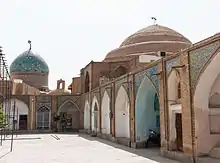 An overview of the religious complex as seen from its courtyard | |
| Religion | |
| Affiliation | Twelver Shi'ite |
| Province | Isfahan Province |
| Location | |
| Location | Isfahan, Iran |
| Municipality | Isfahan |
 Shown within Iran | |
| Geographic coordinates | 32°39′47″N 51°41′09″E / 32.663186°N 51.685767°E |
| Architecture | |
| Type | mosque, mausoleum, Imamzadeh |
| Completed | Shayah Mosque in the 11th century, Imamzadeh Ismail in the 17th century |
| Specifications | |
| Dome(s) | 2 |
| Minaret(s) | 1 (belonging to Shayah Mosque) |
Imamzadeh Ismail and Shayah Mosque (Persian: امامزاده اسماعیل و مسجد شیعه) is a historical funerary religious complex in Isfahan, Iran, which dates back to both the Seljuk and Safavid periods.[1][2] This complex is number 112 on the list of Iran's national monuments, and it comprises the Imamzadeh Ismail and the Shayah Mosque.[3]
Overview
The original structure was a pre-Islamic building that was converted into a mosque during the Rashidun conquest of Persia.[4] During the Seljuk period, the mosque became known as Shayah Mosque.[4][2] After the Safavids had taken over Persia, they added a courtyard to the structure, as well as the building of Imamzadeh Ismail.[1][4]
Imamzadeh Ismail
| Imamzadeh Ismail | |
|---|---|
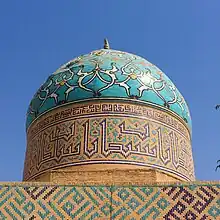 The dome of the Imamzadeh | |
| Architecture | |
| Type | Imamzadeh |
| Completed | 17th century |
The Imamzadeh Ismail (Persian: امامزاده اسماعيل) is built around the tomb of Ismail, a grandson of the third Ahlulbayt Imam, Hasan ibn Ali.[1] Construction started in the Safavid era during the rule of Shah Abbas I, but it was completed in the 17th century, during the rule of Safi of Persia.[4][1] The dome of the Imamzadeh is decorated with tiles, and underneath the dome is Ismail's grave.[4][1]
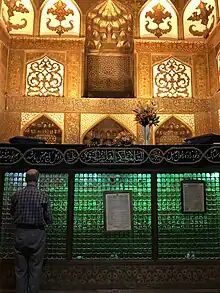
The entrance of the Imamzadeh has two gilded wooden doors with very thin lines of gold on a steel background.[4][1] A hallway within the Imamzadeh holds many paintings, painted by Mohammad Saleh Esfahani.[4][5]
Shayah Mosque
| Shayah Mosque/Shayah-Nabi Tomb | |
|---|---|
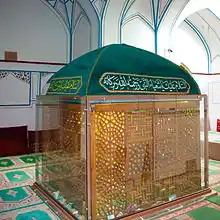 The purported tomb of Isaiah | |
| Architecture | |
| Type | mausoleum |
| Specifications | |
| Minaret(s) | 1 (ruined) |
| Minaret height | 12 metres |
| Materials | brick |
The Shayah Mosque (Persian: مسجد شیعه) or Shayah-Nabi Tomb (مقبره شیاح نبی)[4] is the older part of the religious complex. It dates back to Seljuk period[1][4][5] in the 11th century, and was originally built over a smaller mosque that dated to the Rashidun period.[4][1] The mosque is believe to contain the tomb of Isaiah, who is revered in Islamic tradition as a Prophet and the advisor of Hezekiah.[4][3][1] The mosque's brick minaret dates back to the Seljuk era as well, and it is 12 metres tall, but it is ruined.[4]
Gallery
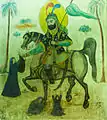 A painting in the Imamzadeh Ismail
A painting in the Imamzadeh Ismail The muqarnas underneath the dome of the Imamzadeh
The muqarnas underneath the dome of the Imamzadeh A sign board at the Shayah Mosque, displaying the Islamic story of Isaiah and a mention of many other tombs dedicated to him throughout Iran
A sign board at the Shayah Mosque, displaying the Islamic story of Isaiah and a mention of many other tombs dedicated to him throughout Iran One of the doors in the religious complex, with muqarnas style above the doorway
One of the doors in the religious complex, with muqarnas style above the doorway
See also
- List of historical structures in Isfahan for a more comprehensive list on the historical sites in Isfahan, Iran
- List of mausoleums in Iran for a complete list of mausoleums in Iran
References
- 1 2 3 4 5 6 7 8 9 "مسجد شعیا و امامزاده اسماعیل؛ نخستین مسجد اصفهان در دل امامزاده - تسنیم". خبرگزاری تسنیم | Tasnim (in Persian). Retrieved 2023-12-06.
- 1 2 "حال و روز امامزاده "اسماعیل" اصفهان - ایسنا". www.isna.ir. Retrieved 2023-12-06.
- 1 2 "مسجد شعیا و امامزاده اسماعیل اصفهان". سایت گردشگری ایران (in Persian). Retrieved 2023-12-06.
- 1 2 3 4 5 6 7 8 9 10 11 12 "راهنمای بازدید از امامزاده اسماعیل و مسجد شعیا در اصفهان | مجله آنیجا". anyja.ir. Retrieved 2023-12-06.
- 1 2 "آرامگاه شعیای نبی و امامزاده اسماعیل (ع) اصفهان استان اصفهان". فروشگاه اینترنتی سی تی مهر (in Persian). Retrieved 2023-12-06.
